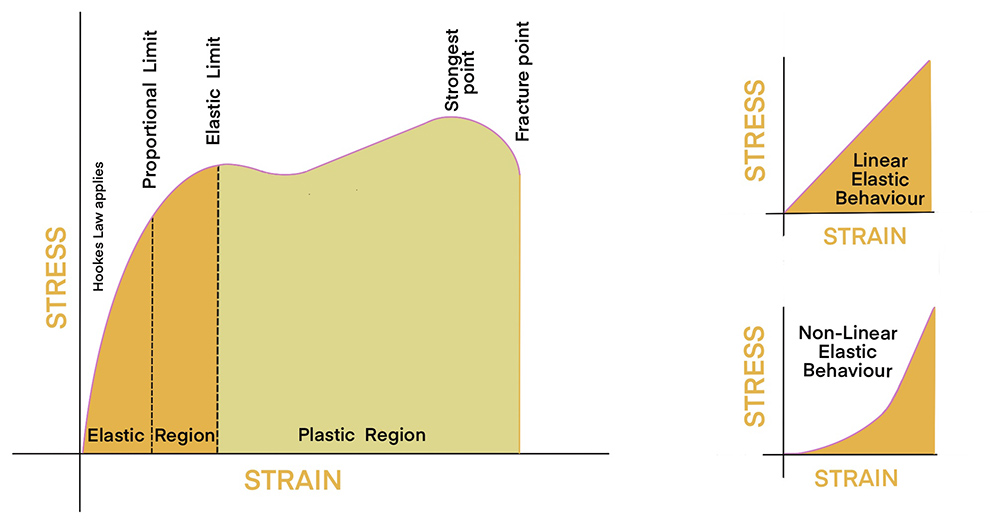Elastic limit
Contents |
[edit] Introduction
All materials show elastic behaviour to a degree, some more than others. If, after a load has been applied and then quickly removed, a material returns rapidly to its original shape, it is said to be behaving elastically. Elasticity is a crucial characteristic of building materials; if it were not, buildings would suffer continuous deformation under load and ultimately would collapse.
[edit] Elastic limit
A solid material’s elastic limit is the maximum stress per unit area it can withstand before there is permanent deformation. In other words, it is the limit of the material’s elasticity, for up to that point, the solid can resume its original shape when the load is removed; after that point, it undergoes permanent (plastic) deformation and will not return to its original shape even after the load (yield load) has been removed.
On a graph showing a stress-strain curve, the point of the limit of elastic behaviour is called the ‘yield point’ and this is where plastic deformation begins – some of this deformation will be plastic and irreversible. In structural engineering, the yield point is regarded as a ‘soft failure’ mode which does not usually cause catastrophic or ultimate failure. It might be referred to as the fracture point or in the case of structural failure the breaking point, such as where a timber beam goes beyond, the yield, soft failure and fracture to break and collapse.
No structural material exhibits perfect elasticity: depending on the type of structure and the material, permanent deformations are unavoidable whenever loads exceed certain values. That is why engineers design structures to ensure the materials are being used within their elastic range and the loads involved will not produce permanent deformations.
All structural materials behave plastically beyond their elastic range. However, even if some materials show elastic behaviour, they may – after a long period of service, usually many years – exhibit a degree of plastic flow (or creep).
[edit] Linear elasticity
This occurs when the deformation in a material is proportional to the load applied. So, if a person weighing 50kg causes a diving board to deflect by 300mm, and another person weighing 100kg causes an identical board to deflect by 600mm, the diving board is exhibiting linear deflection. Most structural materials are, within limits, linearly elastic and are used within their linearly elastic range.
[edit] Related articles on Designing Buildings
- Concept structural design.
- Detailed design.
- Elements of structure in buildings.
- Moment.
- Stiffness.
- Structural engineer.
- Structural principles.
- Structural systems for offices.
- Structural vibration.
- Structures at the end of their design life.
- The development of structural membranes.
- Types of structural load.
- Vibrations.
Featured articles and news
The UK’s largest air pollution campaign.
Future Homes Standard, now includes solar, but what else?
Will the new standard, due to in the Autumn, go far enough in terms of performance ?
BSRIA Briefing: Cleaner Air, Better tomorrow
A look back at issues relating to inside and outside air quality, discussed during the BSRIA briefing in 2023.
Restoring Abbotsford's hothouse
Bringing the writer Walter Scott's garden to life.
Reflections on the spending review with CIAT.
Retired firefighter cycles world to raise Grenfell funds
Leaving on 14 June 2025 Stephen will raise money for youth and schools through the Grenfell Foundation.
Key points for construction at a glance with industry reactions.
Functionality, visibility and sustainability
The simpler approach to specification.
Architects, architecture, buildings, and inspiration in film
The close ties between makers and the movies, with our long list of suggested viewing.
SELECT three-point plan for action issued to MSPs
Call for Scottish regulation, green skills and recognition of electrotechnical industry as part of a manifesto for Scottish Parliamentary elections.
UCEM becomes the University of the Built Environment
Major milestone in its 106-year history, follows recent merger with London School of Architecture (LSE).
Professional practical experience for Architects in training
The long process to transform the nature of education and professional practical experience in the Architecture profession following recent reports.
A people-first approach to retrofit
Moving away from the destructive paradigm of fabric-first.
International Electrician Day, 10 June 2025
Celebrating the role of electrical engineers from André-Marie Amperè, today and for the future.
New guide for clients launched at Houses of Parliament
'There has never been a more important time for clients to step up and ...ask the right questions'
The impact of recycled slate tiles
Innovation across the decades.
EPC changes for existing buildings
Changes and their context as the new RdSAP methodology comes into use from 15 June.
























